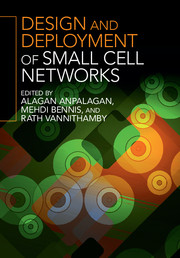Book contents
- Frontmatter
- Contents
- List of contributors
- Preface
- 1 Mobility performance optimization for 3GPP LTE HetNets
- 2 Design and performance analysis of multi-radio small cell networks
- 3 Dynamic TDD small cell management
- 4 3GPP RAN standards for small cells
- 5 Dense networks of small cells
- 6 Traffic offloading scenarios for heterogeneous networks
- 7 Required number of small cell access points in heterogeneous wireless networks
- 8 Small cell deployments: system scenarios, performance, and analysis
- 9 Temporary cognitive small cell networks for rapid and emergency deployments
- 10 Long-term evolution (LTE) and LTE-Advanced activities in small cell networks
- 11 Game theory and learning techniques for self-organization in small cell networks
- 12 Energy efficient strategies with BS sleep mode in green small cell networks
- 13 Mobility management in small cell heterogeneous networks
- 14 The art of deploying small cells: field trial experiments, system design, performance prediction, and deployment feasibility
- 15 Centralized self-optimization of interference management in LTE-A HetNets
- 16 Self-organized ICIC for SCN
- 17 Large-scale deployment and scalability
- 18 Energy efficient heterogeneous networks
- 19 Time- and frequency-domain e-ICIC with single- and multi-flow carrier aggregation in HetNets
- Index
- References
11 - Game theory and learning techniques for self-organization in small cell networks
Published online by Cambridge University Press: 05 December 2015
- Frontmatter
- Contents
- List of contributors
- Preface
- 1 Mobility performance optimization for 3GPP LTE HetNets
- 2 Design and performance analysis of multi-radio small cell networks
- 3 Dynamic TDD small cell management
- 4 3GPP RAN standards for small cells
- 5 Dense networks of small cells
- 6 Traffic offloading scenarios for heterogeneous networks
- 7 Required number of small cell access points in heterogeneous wireless networks
- 8 Small cell deployments: system scenarios, performance, and analysis
- 9 Temporary cognitive small cell networks for rapid and emergency deployments
- 10 Long-term evolution (LTE) and LTE-Advanced activities in small cell networks
- 11 Game theory and learning techniques for self-organization in small cell networks
- 12 Energy efficient strategies with BS sleep mode in green small cell networks
- 13 Mobility management in small cell heterogeneous networks
- 14 The art of deploying small cells: field trial experiments, system design, performance prediction, and deployment feasibility
- 15 Centralized self-optimization of interference management in LTE-A HetNets
- 16 Self-organized ICIC for SCN
- 17 Large-scale deployment and scalability
- 18 Energy efficient heterogeneous networks
- 19 Time- and frequency-domain e-ICIC with single- and multi-flow carrier aggregation in HetNets
- Index
- References
Summary
Small cell networks
The tremendous increase of bandwidth-craving mobile applications (e.g., video streaming, video chatting, and online gaming) has posed enormous challenges to the design of future wireless networks. Deploying small cells (e.g., pico, micro, and femto) has been shown to be an efficient and cost-effective solution to support this constantly rising demand since the smaller cell size can provide higher link quality and more efficient spatial reuse [1]. Small cells could also deliver some other benefits such as offloading the macro network traffic, providing service to coverage holes and regions with poor signal reception (e.g., macro cell edges). Following this trend, the evolving 5G networks [2] are expected to be composed of hundreds of interconnected heterogeneous small cells.
Figure 11.1 gives an illustration of a heterogeneous network (HetNet) where a macro cell is underlaid with different types of small cells. Different from the cautiously planned traditional network, the architecture of a HetNet is more random and unpredictable due to the increased density of small cells and their impromptu way of deployment. In this case, the manual intervention and centralized control used in traditional network management will be highly inefficient, time consuming, and expensive, and therefore will be not applicable for dense heterogeneous small cell networks. Instead, self-organization has been proposed as an essential feature for future small cell networks [3, 4].
The motivations for enabling self-organization in small cell networks are explained below.
• Numerous network devices with different characteristics are expected to be interconnected in future wireless networks. Also, these devices are expected to have “plug and play” capability. Therefore the initial pre-operational configuration has to be done with minimum expertise involvement.
• With the emergence of small cells, the spatio-temporal dynamics of the networks has become more unpredictable than legacy systems due to the unplanned nature of small cell deployment. Therefore intelligent adaptation of the network nodes is necessary. That is, the self-organizing small cells need to learn from the environment and adapt with the network dynamics to achieve the desired performance.
- Type
- Chapter
- Information
- Design and Deployment of Small Cell Networks , pp. 242 - 283Publisher: Cambridge University PressPrint publication year: 2015



